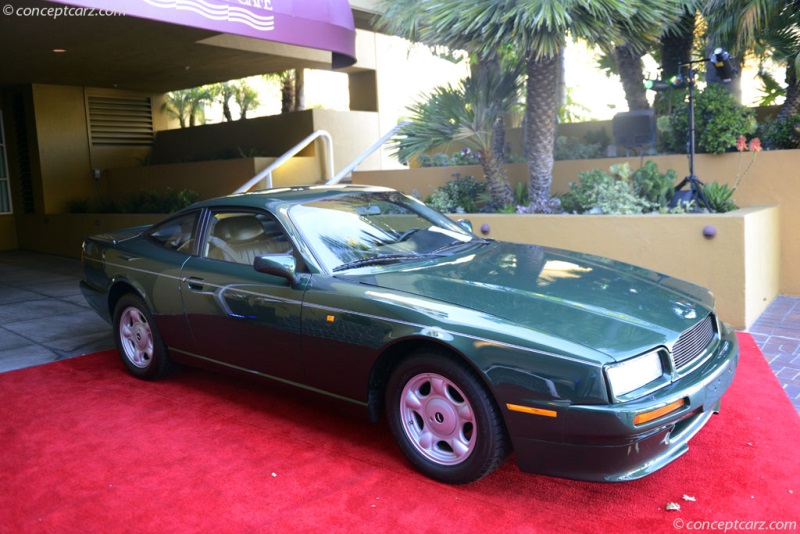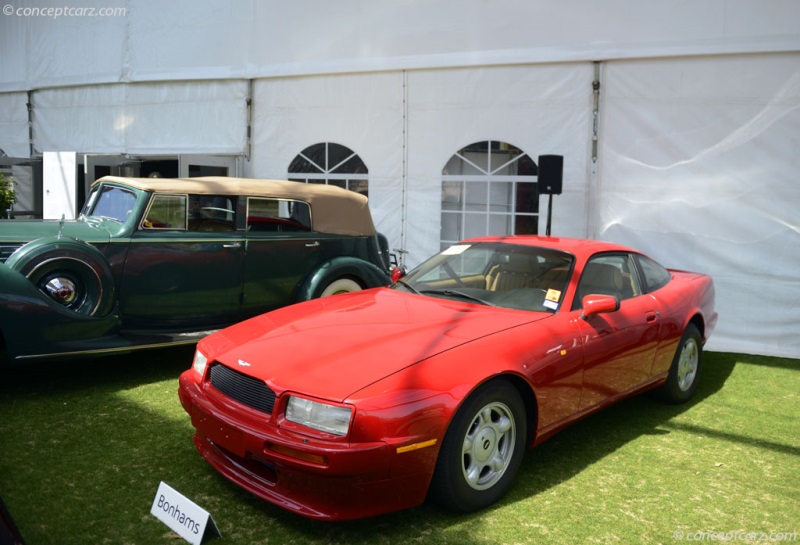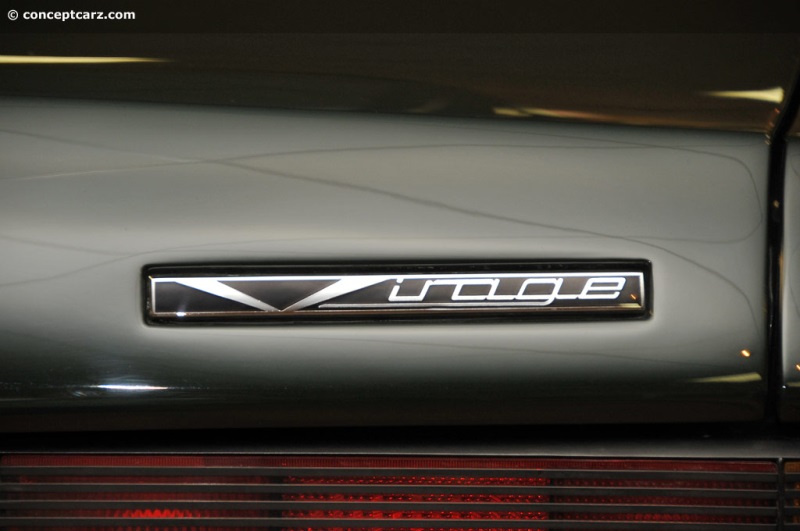History
An extremely impressive machine, which no one can deny, the Virage had a hand built body that oozed exclusivity. Aston Martin's replacement for the out-dated V8 models, the Virage was originally unveiled at the Birmingham Motor Show in 1988. The Virage was joined by the very high-performance Vantage in 1993 and the standard car was renamed V8 in 1996. Introduced to the market in 1990, the Aston Martin Virage was available as a 2 door, 4- seater Coupe and a total of 370 units were produced during its three year production run. 1,050 of all Virage related models had been produced by the end of the 2000 model year. Intended to be the branch out model, the new V8 model, the Virage was intended to be a new 'world car' for Aston Martin, which meant that it could be sold in all markets without any huge updates or modifications to either the body or the engine.
Until the summer of 1990, the Virage was not available in the U.S. and it wasn't until 1992 that the Virage Volante convertible was available also in the U.S. The Virage Vantage was never officially offered for sale in the U.S., and no 1995 models were ever imported to the U.S. and 1996 was the final year of availability for the Virage in the U.S.
Aston Marton had high hopes that this V8-powered vehicle would be the company's top model with the 6-cylinder 1994 DB7 placed in the slot directly below it. The V8 model, by then in Vantage form remained the most pricey, exclusive hand-built leader of Aston's, even though the DB7 switched to a V12 engine and held the lead in performance.
The original 5.3 liter V8 engine would be utilized but with a new 32 valve version that was fitted with Weber fuel injection which elevated its performance close to a sports cars levels. The Virage featured a very modern and ‘vintage style' design resembling a Lagonda more than the V8 that it was replacing. The Virage had an all new body though it used the traditional Aston alloy panels joined onto a steel frame/chassis. The chassis was an evolution of the Lagonda's, though it didn't featured the de Dion tube rear suspension, rather a bulky aluminum A-frame design. Needing a replacement under warranty for the first few vehicles, the independent rear suspension sat on an 'A' frame carrier.
Much like many earlier Aston models, many of the less important parts and pieces of the Virage came from a variety of other companies to keep costs low. The streamlined headlights came from the Audi 200, while the taillights were imported from the Volkswagen Scirocco. The climate control panel, dash switches and the steering column were taken from Jaguar, GM and Ford. Very shortly after the Virage was introduced, Ford purchased both Jaguar and Aston Martin.
A large, very heavy car, weighing around 3,950 lbs, the 1990 Aston Martin Virage sat on a wheelbase of 102.8 inches, had an overall length of 186.4 inches and priced new from $150,000 to $258,648. The very exclusive Virage had amazingly svelte styling and could achieve 0-60 mph in just 6 seconds and had a top speed of 158 mp. According the Sports Car International on a first test 'Acceleration just never seems to run out', and 'Nothing sounds quite like an Aston V8'. .
Unfortunately the Aston Martin Virage was not made as well as hoped, and a variety of quality, design faults and new emission laws, coupled with a world-wide recession in the early 90's, doomed the beautiful car. A variety of different versions were speedily developed from the Virage coupe including a 2+2 Volante, high performance '6.3 liter' conversions, and two and four door 'Shooting Brakes' by the factory. In 1994, only 9 models were made into a special 'Virage LE' Limited Edition. These exclusive nine models featured unique paint, trim, front grille and analogue instruments that were brought over from the Virage Volante. Original Virage Coupes featured arduous trip computer units and electronic dashes.
In 1992 the Virage Volante convertible was introduced as a 2-seat vehicle, though all production examples showcased 2+2 seating. Before the series ended production in 1996, an estimated 224 to 233 examples had been created. A shooting brake (estate) version was also offered in very limited supply in 1992. This Virage was only produced in-house by the company's Works Service, and only four estimated models were ever produced. Another just as rare production by Aston Works Service was the Lagonda Saloon. These long-wheelbase 4-door Virages were only constructed as a special customer order and only four of these models were ever produced. The last Virage Variant was the exclusive V8 Vantage in 2000, and only nine of these ultra hig-performance models were ever produced.
In January of 1992, Aston Martin introduced a conversion service which transformed the vehicle into a Virage 6.3. This conversion included a 6.3 L V8 that was derived from the AMR1 racing vehicle being converted. The engine in the model produced 500 hp at 6000 rpm and 480 ft/lb of torque at 5800 rpm which clocked the top speed at 175 mph. The 6.3 Virage also featured 18 inch wheels and 14 inch ventilated disc brakes, which were the largest that were used in a passenger vehicle until the introduction of the Bentley Continental GT. The Virage 6.3 featured low sills and air dams, side air vents and wide flared bumpers. Around 63 models were produced before the 2000 model was replaced with the Vanquish and the V8 Vantage name was again shown on a new entry-level model in 2005.
Eventually, a high-performance Vantage model of the Virage would appear, though the Virage nomenclature only lasted a few years, its final descendants would someday inherit the simple and very familiar V8 name.By Jessica Donaldson
Until the summer of 1990, the Virage was not available in the U.S. and it wasn't until 1992 that the Virage Volante convertible was available also in the U.S. The Virage Vantage was never officially offered for sale in the U.S., and no 1995 models were ever imported to the U.S. and 1996 was the final year of availability for the Virage in the U.S.
Aston Marton had high hopes that this V8-powered vehicle would be the company's top model with the 6-cylinder 1994 DB7 placed in the slot directly below it. The V8 model, by then in Vantage form remained the most pricey, exclusive hand-built leader of Aston's, even though the DB7 switched to a V12 engine and held the lead in performance.
The original 5.3 liter V8 engine would be utilized but with a new 32 valve version that was fitted with Weber fuel injection which elevated its performance close to a sports cars levels. The Virage featured a very modern and ‘vintage style' design resembling a Lagonda more than the V8 that it was replacing. The Virage had an all new body though it used the traditional Aston alloy panels joined onto a steel frame/chassis. The chassis was an evolution of the Lagonda's, though it didn't featured the de Dion tube rear suspension, rather a bulky aluminum A-frame design. Needing a replacement under warranty for the first few vehicles, the independent rear suspension sat on an 'A' frame carrier.
Much like many earlier Aston models, many of the less important parts and pieces of the Virage came from a variety of other companies to keep costs low. The streamlined headlights came from the Audi 200, while the taillights were imported from the Volkswagen Scirocco. The climate control panel, dash switches and the steering column were taken from Jaguar, GM and Ford. Very shortly after the Virage was introduced, Ford purchased both Jaguar and Aston Martin.
A large, very heavy car, weighing around 3,950 lbs, the 1990 Aston Martin Virage sat on a wheelbase of 102.8 inches, had an overall length of 186.4 inches and priced new from $150,000 to $258,648. The very exclusive Virage had amazingly svelte styling and could achieve 0-60 mph in just 6 seconds and had a top speed of 158 mp. According the Sports Car International on a first test 'Acceleration just never seems to run out', and 'Nothing sounds quite like an Aston V8'. .
Unfortunately the Aston Martin Virage was not made as well as hoped, and a variety of quality, design faults and new emission laws, coupled with a world-wide recession in the early 90's, doomed the beautiful car. A variety of different versions were speedily developed from the Virage coupe including a 2+2 Volante, high performance '6.3 liter' conversions, and two and four door 'Shooting Brakes' by the factory. In 1994, only 9 models were made into a special 'Virage LE' Limited Edition. These exclusive nine models featured unique paint, trim, front grille and analogue instruments that were brought over from the Virage Volante. Original Virage Coupes featured arduous trip computer units and electronic dashes.
In 1992 the Virage Volante convertible was introduced as a 2-seat vehicle, though all production examples showcased 2+2 seating. Before the series ended production in 1996, an estimated 224 to 233 examples had been created. A shooting brake (estate) version was also offered in very limited supply in 1992. This Virage was only produced in-house by the company's Works Service, and only four estimated models were ever produced. Another just as rare production by Aston Works Service was the Lagonda Saloon. These long-wheelbase 4-door Virages were only constructed as a special customer order and only four of these models were ever produced. The last Virage Variant was the exclusive V8 Vantage in 2000, and only nine of these ultra hig-performance models were ever produced.
In January of 1992, Aston Martin introduced a conversion service which transformed the vehicle into a Virage 6.3. This conversion included a 6.3 L V8 that was derived from the AMR1 racing vehicle being converted. The engine in the model produced 500 hp at 6000 rpm and 480 ft/lb of torque at 5800 rpm which clocked the top speed at 175 mph. The 6.3 Virage also featured 18 inch wheels and 14 inch ventilated disc brakes, which were the largest that were used in a passenger vehicle until the introduction of the Bentley Continental GT. The Virage 6.3 featured low sills and air dams, side air vents and wide flared bumpers. Around 63 models were produced before the 2000 model was replaced with the Vanquish and the V8 Vantage name was again shown on a new entry-level model in 2005.
Eventually, a high-performance Vantage model of the Virage would appear, though the Virage nomenclature only lasted a few years, its final descendants would someday inherit the simple and very familiar V8 name.By Jessica Donaldson
Aston Martin
Similar Automakers
Similarly Sized Vehicles
from 1991
1991 Aston Martin Virage Vehicle Profiles
Recent Vehicle Additions
Performance and Specification Comparison
Price Comparison
Virage Specification Comparison by Year
Year
Production
Wheelbase
Engine
Prices
Related Automotive News

Show-Quality, Coachbuilt Italian Exotics, Including Zagato-Bodied Maserati A6G/54 Berlinetta and ex-Emperor Bao Dai Ferrari 410 Superamerica, Announced for Pebble Beach
Gooding %26 Companys Pebble Beach Auctions to feature lineup of concours-level Italian classics from Ferrari, Maserati, Lamborghini, Lancia, and a one-off Serenissima by Ghia.
International auction house Gooding %26 Company has announced...

Gooding & Company Unveils Online Catalogue for Pebble Beach Auctions, Announces Additional Star Consignments
The catalogue features major new additions from the auction house, including a 1959 Ferrari 250 GT LWB California Spider Competizione, a 1998 Mercedes-Benz AMG CLK GTR Strassenversion, a 1957 Maserati 200 SI, and a 1961 Aston Martin DB4 GT.
The...

Lamborghini Marzal at the GP de Monaco Historique
History repeats itself the Lamborghini Marzal made its first outing since 1967 at the GP de Monaco Historique driven by Prince Albert of Monaco
SantAgata BologneseMonte Carlo, 14 May 2018 – Lamborghini Polo Storico went back in history...
Aston Martin AM37s Drops Anchor At The Fort Lauderdale Boat Show
Aston Martin AM37S powerboat will be displayed at the 58th Fort Lauderdale International Boat Show on November 1- 5, 2017
Quintessence Yachts will again collaborate with Feadship, after a successful cooperation at the Monaco Yacht Show in September...
RENAULT ANNOUNCES UK SPECIFICATION AND PRICING FOR NEW RENAULT TWINGO GT AND ENHANCED DYNAMIQUE S
New Renault Twingo GT and updated Dynamique S available to order from 1st December
Renault Sport-developed Twingo GT produces 110hp and 170Nm torque
Engine upgrades include a modified turbocharger, revised engine mapping and specially-developed ex...




































